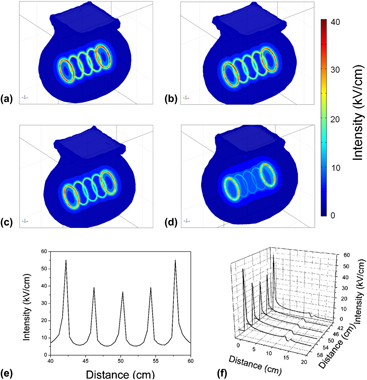Crossref Citations
This article has been cited by the following publications. This list is generated based on data provided by
Crossref.
Wang, Xin
Lin, Tong
and
Wang, Xungai
2014.
Scaling up the production rate of nanofibers by needleless electrospinning from multiple ring.
Fibers and Polymers,
Vol. 15,
Issue. 5,
p.
961.
Wang, Xin
Zhao, Yuan
Wang, Hao
and
Cai, Guang Ming
2014.
Electric Field and Spinning Performance in Needleless Electrospinning.
Advanced Materials Research,
Vol. 1048,
Issue. ,
p.
26.
Hsieh, Chien-Teng
Lou, Ching-Wen
Pan, Yi-Jun
Huang, Chien-Lin
Lin, Jia-Horng
Lin, Zheng-Ian
Chen, Yueh-Sheng
and
Chiang, Kun-Chien
2016.
Fabrication of poly(vinyl alcohol) nanofibers by wire electrode-incorporated electrospinning.
Fibers and Polymers,
Vol. 17,
Issue. 8,
p.
1217.
Stoddard, Ryan J
Steger, Arielle L
Blakney, Anna K
and
Woodrow, Kim A
2016.
In Pursuit of Functional Electrospun Materials for Clinical Applications in Humans.
Therapeutic Delivery,
Vol. 7,
Issue. 6,
p.
387.
Ali, Usman
Niu, Haitao
Aslam, Sarmad
Jabbar, Abdul
Rajput, Abdul Waqar
and
Lin, Tong
2017.
Needleless electrospinning using sprocket wheel disk spinneret.
Journal of Materials Science,
Vol. 52,
Issue. 12,
p.
7567.
Wang, Li
Ahmad, Zeeshan
Huang, Jie
Li, Jing-Song
and
Chang, Ming-Wei
2017.
Multi-compartment centrifugal electrospinning based composite fibers.
Chemical Engineering Journal,
Vol. 330,
Issue. ,
p.
541.
Wang, Baolin
Zhou, Wenyan
Chang, Ming‐Wei
Ahmad, Zeeshan
and
Li, Jing‐Song
2017.
Impact of substrate geometry on electrospun fiber deposition and alignment.
Journal of Applied Polymer Science,
Vol. 134,
Issue. 19,
Yan, Guilong
Niu, Haitao
Shao, Hao
Zhao, Xueting
Zhou, Hua
and
Lin, Tong
2017.
Curved convex slot: an effective needleless electrospinning spinneret.
Journal of Materials Science,
Vol. 52,
Issue. 19,
p.
11749.
Ali, Usman
Abbass, Amir
Khurshid, Furqan
Aslam, Sarmad
and
Waqar, Abdul
2017.
Needleless Electrospinning Using a Flat Wheel Spinneret.
Journal of Engineered Fibers and Fabrics,
Vol. 12,
Issue. 3,
Wang, Yi-qi
Zhang, Xin
and
Pan, Zhi-juan
2018.
A Novel Method to Fabricate High Strength Nanofiber Filaments: Morphology, Crystalline Structure, and Thermal and Mechanical Properties.
Fibers and Polymers,
Vol. 19,
Issue. 6,
p.
1245.
Yan, Guilong
Niu, Haitao
Zhou, Hua
Wang, Hongxia
Shao, Hao
Zhao, Xueting
and
Lin, Tong
2018.
Electro-aerodynamic field aided needleless electrospinning.
Nanotechnology,
Vol. 29,
Issue. 23,
p.
235302.
Lee, Bong-Kee
Park, Jae-Han
Park, Geon-Jung
and
Park, Kwang-Ryun
2018.
Multi-Nozzle Electrospinning Process to Fabricate Uniform Polymer Nanofiber Mats.
Journal of the Korean Society of Manufacturing Process Engineers,
Vol. 17,
Issue. 3,
p.
120.
Buzgo, Matej
Mickova, Andrea
Rampichova, Michala
and
Doupnik, Miroslav
2018.
Core-Shell Nanostructures for Drug Delivery and Theranostics.
p.
325.
Patel, Swayamprakash
and
Patel, Gayatri
2019.
A Review and Analysis on Recent Advancements in Bubble Electrospinning Technology for Nanofiber Production.
Recent Patents on Nanotechnology,
Vol. 13,
Issue. 2,
p.
80.
Liu, Qingjie
Wu, Qiang
Xie, Songzhi
Zhao, Long
Chen, Zhoujiang
Ding, Zhenghua
and
Li, Xiaohong
2019.
Uniform field electrospinning for 3D printing of fibrous configurations as strain sensors.
Nanotechnology,
Vol. 30,
Issue. 37,
p.
375301.
Ro, Yong-Chil
Ri, Yong-Il
and
Jong, Guang-Jin
2019.
Manufacturing of High-efficiency Air Filter Paper Using Ultra-fine Fibers.
Paper and Biomaterials,
Vol. 4,
Issue. 1,
p.
17.
Jahan, Israt
Jadhav, Amit
Wang, Lijing
and
Wang, Xin
2019.
Electrospinning from a convex needle with multiple jet toward better controlling and enhanced production rate.
Journal of Applied Polymer Science,
Vol. 136,
Issue. 40,
Chen, Mingjun
Zhang, Youchen
Chen, Xiaoqing
Yang, Weimin
Li, Haoyi
Yousefzadeh, Maryam
and
Ramakrishna, Seeram
2020.
Polymer melt differential electrospinning from a linear slot spinneret.
Journal of Applied Polymer Science,
Vol. 137,
Issue. 31,
Xiong, Jian
Liu, Ye
Li, Ailin
Wei, Liang
Wang, Liming
Qin, Xiaohong
and
Yu, Jianyong
2021.
Mass production of high-quality nanofibers via constructing pre-Taylor cones with high curvature on needleless electrospinning.
Materials & Design,
Vol. 197,
Issue. ,
p.
109247.
Jahan, Israt
and
Wang, Xin
2021.
Electrospun Polymers and Composites.
p.
765.


